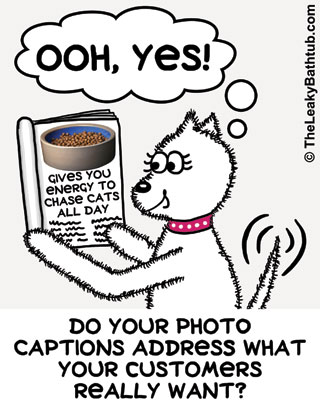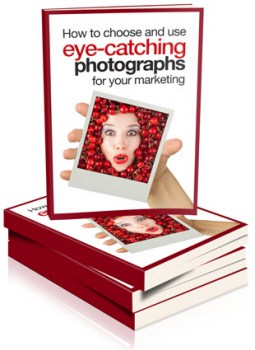
In the last post on writing photo captions we touched on incorporating a feature and benefit of your product and service in your photo captions.
But what’s the difference between a feature and a benefit?
Knowing the difference between a feature and a benefit is Marketing 101, but I’ve many small business owners struggle to differentiate between features and benefits when it comes to their own business. So if you’re not clear what the difference is, you’re not alone… and by the end of this article you should have a better idea of how this works for your own business.
Once you’ve got that sussed, it’ll help you with many aspects of your marketing – not just photo captions!
Features
Features are fact-based, but by themselves, they’re pretty boring. Here are some examples of features:
- Car: does 50 miles per gallon.
- Dog food: contains 20% vegetables.
- Fountain pen: has a flexible tip.
- Accountant: provides clients with monthly reporting.
- Window cleaning service: uses chemical-free products.
Viewed in isolation, most of these statements promote a “so what” response… so what if a dog food contains 20% vegetables? So what if a pen has a flexible tip? Features by themselves don’t make for exciting, compelling or memorable marketing. You need to put the feature into some kind of context.
Benefits put features into context
And that’s where the benefits come in: they put the feature into context, usually by drawing on some kind of emotion. For example:
- Car: Because it does 50 miles per gallon, you can spend your money on more fun stuff.
- Dog food: nutritionally-balanced to keep your pet fit and healthy for longer.
- Fountain pen: the flexible tip enhances your hand writing.
- Accountant: monthly reports come with easy-to-understand commentary so you know if your business is healthy – or in the danger zone.
- Window cleaning service: not only will your windows be clean, but the products we use are allergy-free for your family and pets.
Do you notice something about these emotions?
Sometimes the benefit draws on happy emotions (doing fun stuff; having a fit and healthy dog), but other times the benefit draws into a more negative emotion. For example, this fountain pen might appeal to those who are ashamed of their handwriting. And the accountant’s service taps into the fear that entrepreneurs may have of business failure. And so on.
So should you tap into a positive or a negative emotion? There’s no hard and fast rule here, it depends on your product or service, and it depends on your industry. But most if all, it depends on your target customer’s needs and desires. (And to do that, you need to really get to know what motivates your customers. How? Asking them is the only sure-fire way to find out.)
Customers have a mix of emotions going on inside them
Often people will have a mixture of emotional drivers, but at the time of purchase one is often stronger than the others, which is why they’re taking the plunge to buy from you.
How does this tie into marketing – and into photo caption writing?
To market your product or service successfully, you need to hook into those emotionally-based buying decisions. And to do that, you need to recognise that your product or service has two levels:
- The basic need, which is where the logical stuff comes into it.
- The augmented need, which is where your heart and emotions start getting involved.
![brain-vs-heart-500 20% of buying decisions are based on logic [brain: basic need]... 80% of buying decisions are based on emotions [heart: augmented need]](/wp-content/uploads/2012/06/brain-vs-heart-500.jpg)
In short: there’s a difference between the things we need, and the things we want. We may not need that new dress we’ve just splurged on, but we want to feel good about ourselves.
Let’s just look at these emotionally-based augmented needs in a little more details, so you can understand just how far you can go with stating the benefits of your product or service.
The classic example of the drill manufacturer…
Have you heard the saying that people don’t want to buy a drill, they want a hole?
Actually, that’s wrong. They don’t want the hole: they want to hang a painting, or put up some shelves. And there are emotions around that seemingly straightforward desire to have a hole. The customer might be feeling:
- One-upmanship: they want to show off their new art to friends and family.
- Nesting: they want to create a cosy, comfortable home.
- Frustration: they’re fed up with the house looking a mess, and they doing something about it by putting up shelves. (Or maybe they’re frustrated with the lady of the house, who keeps asking for shelves to be installed!)
- Procrastination: they don’t like home maintenance.
- Fear: they don’t like using power tools… but know they have to.
Let’s look at some photo caption examples to give you an idea of what works and what doesn’t work, so you can see how to tie in emotional benefits into the features:

This caption makes me think, “so what”? Just stating a feature does nothing for me. Is a 1.5Ahr battery good or bad? I have no idea!

This is better! Notice how this caption incorporates a feature (the 1.5Ahr battery) as well as a benefit. It makes it clear to the reader that a 1.5Ahr battery is a good thing to have.
Let’s look at a service-based example too: a real estate agent
The basic, logical need that a real estate agent fulfils is that to sell a house.
The augmented needs (emotional drivers) around the desire to engage a real estate agent might include:
- Wealth-driven: wanting to get the highest possible price for your house.
- Fear: some people hate negotiating and want someone to do that for them.
- Convenience and time-saving: having someone else take care of viewings.
Let’s look at a poor example of a photo caption, so you can see what to avoid writing:

This caption attempts to state a benefit: but without a feature to back it up, it’s wishy-washy and provokes a “so what” response. Essentially it’s just a bland statement.
A better example is as follows:

Again, the good example includes a feature as well as a benefit. By including a specific statistic, the statement comes across as being more credible. It packs punch. (You can read more tips on using numbers in your copy here.)
You need to include the logic as well as the emotion
Just because buying decision are 80% emotionally-based, it doesn’t mean that you can forget about the 20% logical (feature-based) element. Consumers will need some logic when justifying the purchase either in their own minds, or to their spouse or friends.
Example: justifying a purchase in your own mind
“I can justify buying the top-of-the-range drill with the extra powerful battery, because I can get those chores done more quickly.”
Example: justifying a purchase to others
“Yeah, I know the car looks quite flashy, but it actually does 50 miles per gallon, so it’ll pay for itself in no time.”
…or the more common line of: “I needed to buy this dress, honey. It’s so versatile I can wear it for work and your business dinner. And it was 50% off in the sale, you know!”
In short: your marketing need to address the features AND the benefits of your product or service. One without the other will not work!
Summary
- Features by themselves are boring and provoke a “so what” response.
- Benefits by themselves can be wishy-washy and may also provoke a “so what” response.
- Benefits put features into context.
- Benefits should draw on emotions: either positive or negative.
- You need to draw on the strongest emotion that your customer is likely to be feeling when purchasing your product or service.
- It’s important to still state the feature in your marketing, because consumers will need this to justify their purchase (in their own minds, or to other people).
- Combining a feature and benefit in photo captions gives it maximum impact.

Are you looking for more ways to make your marketing photography more effective?
Discover more tips on making your marketing photography more persuasive in my eBook ‘How to Choose and Use Eye-Catching Photographs for your Marketing’.



